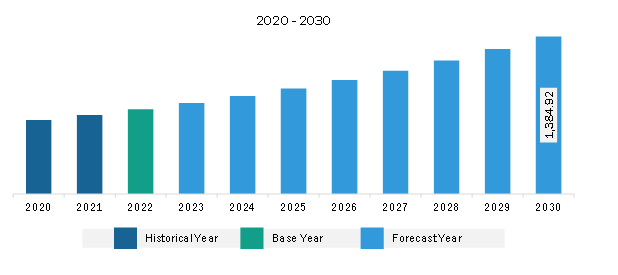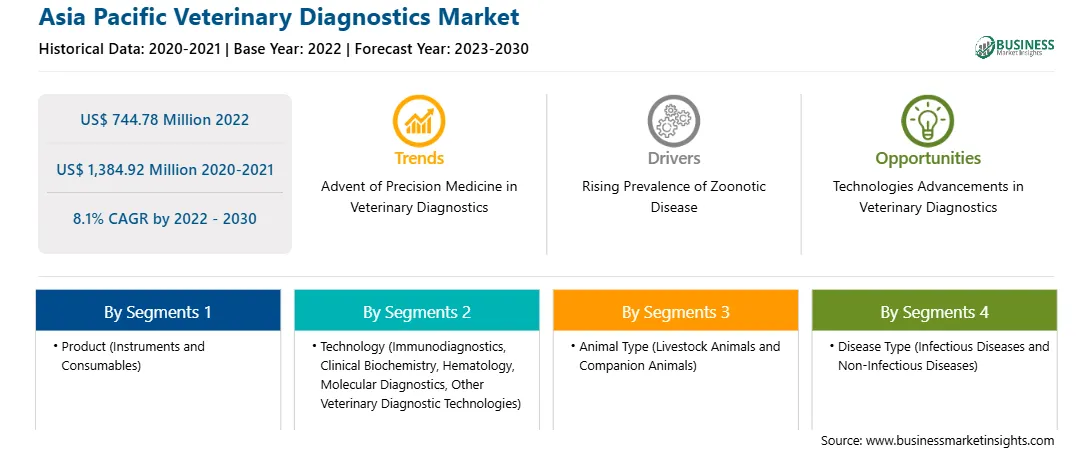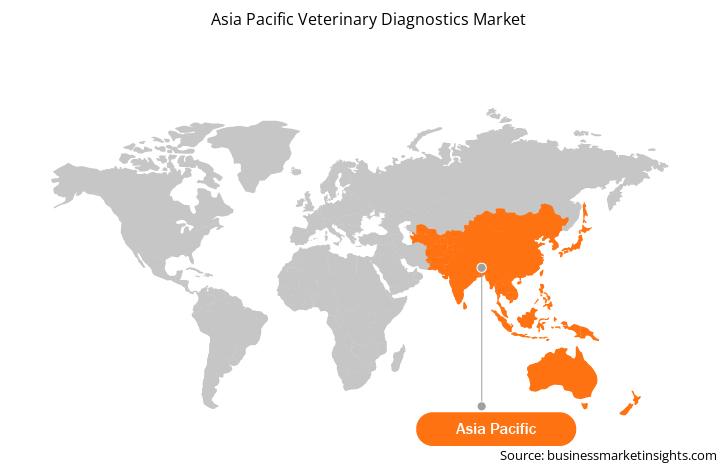The Asia Pacific veterinary diagnostics market was valued at US$ 744.78 million in 2022 and is expected to reach US$ 1,384.92 million by 2030; it is estimated to grow at a CAGR of 8.1% from 2022 to 2030.
Rising Prevalence of Zoonotic Disease Fuel Asia Pacific Veterinary Diagnostics Market
Zoonotic diseases cause illnesses not only in animals but also in humans. These infections can cause from mild to severe conditions. As per the Council on Foreign Relations, zoonoses cause 2.5 billion illnesses and 2.7 million deaths each year globally, accounting for 60% of known infectious diseases and 75% of new or emerging infectious diseases. Also, according to Centers for Disease Control and Prevention, in 2023, 6 out of every 10 infectious diseases in humans are spread by animals, and 3 of 4 new or emerging infectious diseases are transferred by animals. Further, dogs contribute to 99% of all rabies transmissions to humans and are a major source of human rabies deaths. The economic burden due to dog-mediated rabies is estimated to be US$ 8.6 billion/year globally. According to the World Health Organization (WHO), rabies occurs in more than 150 countries and causes tens of thousands of deaths yearly, particularly in Asia and Africa. The International Livestock Research Institute estimates that 13 zoonoses cause 2.4 billion cases of human disease and 2.2 million deaths annually in India. The International Livestock Research Institute estimates that 13 zoonoses cause 2.4 billion cases of human disease and 2.2 million deaths annually in India.
Southeast Asia region is a hotspot for zoonotic illnesses due to factors including population growth and travel, deforestation, agricultural and meat production, wildlife consumption and commerce, and climate change. The last century has seen a number of zoonotic viral outbreaks in the region, ranging in size and scope. Notably, large outbreaks of the highly pathogenic avian influenza H5N1, the Chikungunya virus, and SARS have been reported, causing serious concern as well as significant health and economic effects, aside from the SARS-CoV-2 pandemic. According to the World Health Organization (WHO), rabies occurs in more than 150 countries and causes tens of thousands of deaths yearly, particularly in Asia and Africa. Thus, the rising rabies globally increases the need for diagnoses of the illnesses, contributing to the growth of the veterinary diagnostics market. Also, the rising prevalence of zoonotic diseases globally accelerates the demand for veterinary diagnostics.
Asia Pacific Veterinary Diagnostics Market Overview
According to the Department of Agriculture, Fisheries and Forestry report, the Japanese Encephalitis (JE) virus-spread by mosquitoes-negatively affects the reproductive performance of pigs; it also causes viral encephalitis in humans. In 2022, Australia experienced an outbreak of JEV in domestic pigs, accounting for detections in over 80 piggeries in Queensland, New South Wales (NSW), Victoria, and South Australia. In March 2022, the first JEV outbreak in Australia resulted in the declaration of a Communicable Disease Incident of National Significance (CDINS). Australia is well placed to continue to manage the risk of JEV. For instance, in June 2023, the CDINS declared JEV as an outbreak, and the nation is well prepared to handle future outbreaks with a dedicated response. The Public Library of Science (PLoS) reports that the incidence of infectious diseases has increased in Asia Pacific since 2020. For example, increased encroachment of farms on wildlife habitats has resulted in the reach of livestock and wild animals with severe consequences of accelerating emerging infectious/zoonotic diseases from wild animals. Therefore, the Asia Pacific strategy for emerging diseases has benefitted from controlling the prevalence of infectious diseases in animals.
Regionally and globally, zoonotic diseases are recognized closely by the Food and Agriculture Organization of the United Nations (FAO), the World Organisation for Animal Health (OIE), and WHO working in Asia Pacific. As per the Accelerating One Health in Asia and the Pacific report, the concept and importance of One Health approach is gaining significant attention due to ecosystem degradation, biodiversity loss, and climate change putting public health challenges at the human-animal-environment interface in Asia Pacific. Therefore, the adoption of One Health approaches can assist Asia Pacific countries to progress through multiple sectors and stakeholders' engagement. These engagements are conducted in terms of human health, terrestrial and aquatic animal health, and food production to ultimately improve outcomes essential to achieve the Sustainable Development Goals (SDGs).
Asia Pacific Veterinary Diagnostics Market Revenue and Forecast to 2030 (US$ Million)

Strategic insights for the Asia Pacific Veterinary Diagnostics provides data-driven analysis of the industry landscape, including current trends, key players, and regional nuances. These insights offer actionable recommendations, enabling readers to differentiate themselves from competitors by identifying untapped segments or developing unique value propositions. Leveraging data analytics, these insights help industry players anticipate the market shifts, whether investors, manufacturers, or other stakeholders. A future-oriented perspective is essential, helping stakeholders anticipate market shifts and position themselves for long-term success in this dynamic region. Ultimately, effective strategic insights empower readers to make informed decisions that drive profitability and achieve their business objectives within the market.

| Report Attribute | Details |
|---|---|
| Market size in 2022 | US$ 744.78 Million |
| Market Size by 2030 | US$ 1,384.92 Million |
| Global CAGR (2022 - 2030) | 8.1% |
| Historical Data | 2020-2021 |
| Forecast period | 2023-2030 |
| Segments Covered |
By Product
|
| Regions and Countries Covered | Asia-Pacific
|
| Market leaders and key company profiles |
The geographic scope of the Asia Pacific Veterinary Diagnostics refers to the specific areas in which a business operates and competes. Understanding local distinctions, such as diverse consumer preferences (e.g., demand for specific plug types or battery backup durations), varying economic conditions, and regulatory environments, is crucial for tailoring strategies to specific markets. Businesses can expand their reach by identifying underserved areas or adapting their offerings to meet local demands. A clear market focus allows for more effective resource allocation, targeted marketing campaigns, and better positioning against local competitors, ultimately driving growth in those targeted areas.

1. FUJIFILM Holdings Corp
2. Heska Corp
3. Idexx Laboratories Inc
4. Merck Animal Health
5. Neogen Corp
6. Randox Laboratories Ltd
7. Thermo Fisher Scientific Inc
8. Virbac SA
9. Zoetis Inc
The Asia Pacific Veterinary Diagnostics Market is valued at US$ 744.78 Million in 2022, it is projected to reach US$ 1,384.92 Million by 2030.
As per our report Asia Pacific Veterinary Diagnostics Market, the market size is valued at US$ 744.78 Million in 2022, projecting it to reach US$ 1,384.92 Million by 2030. This translates to a CAGR of approximately 8.1% during the forecast period.
The Asia Pacific Veterinary Diagnostics Market report typically cover these key segments-
The historic period, base year, and forecast period can vary slightly depending on the specific market research report. However, for the Asia Pacific Veterinary Diagnostics Market report:
The Asia Pacific Veterinary Diagnostics Market is populated by several key players, each contributing to its growth and innovation. Some of the major players include:
The Asia Pacific Veterinary Diagnostics Market report is valuable for diverse stakeholders, including:
Essentially, anyone involved in or considering involvement in the Asia Pacific Veterinary Diagnostics Market value chain can benefit from the information contained in a comprehensive market report.